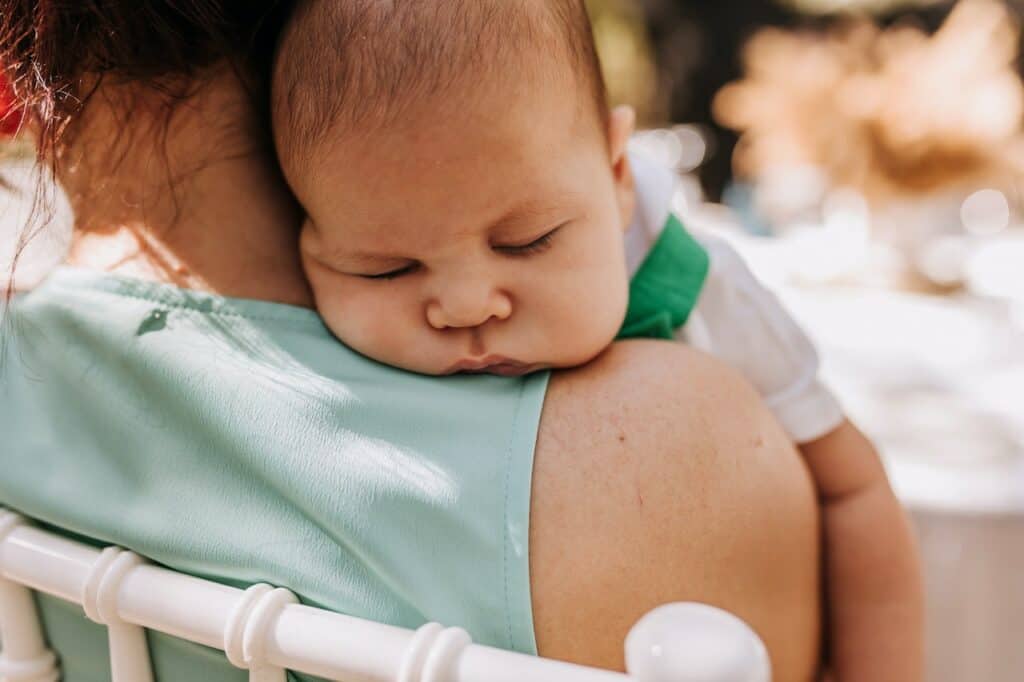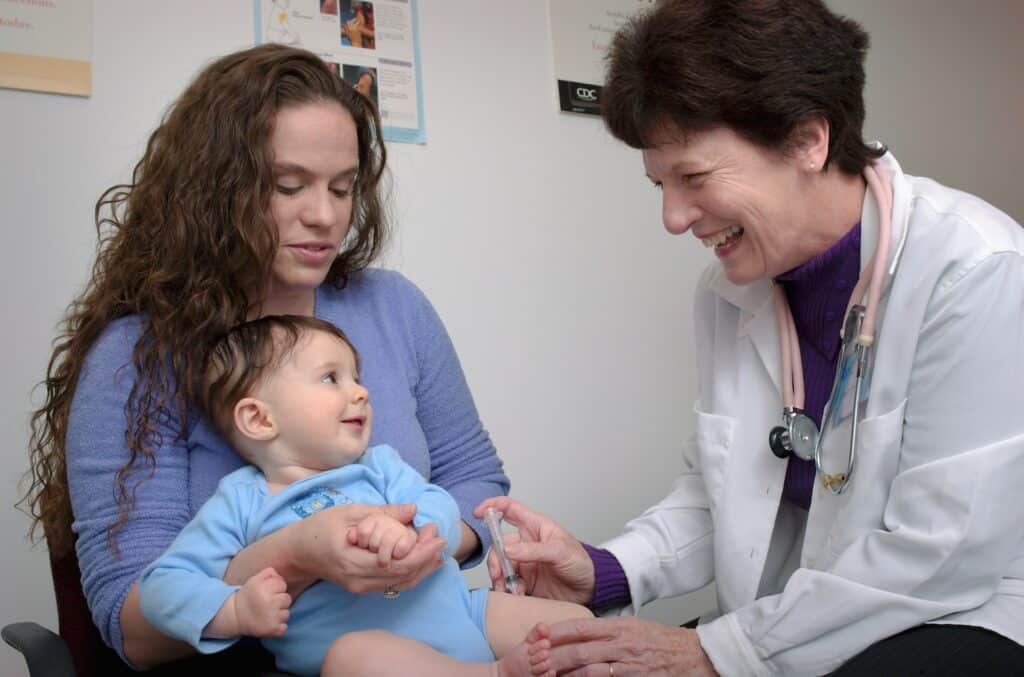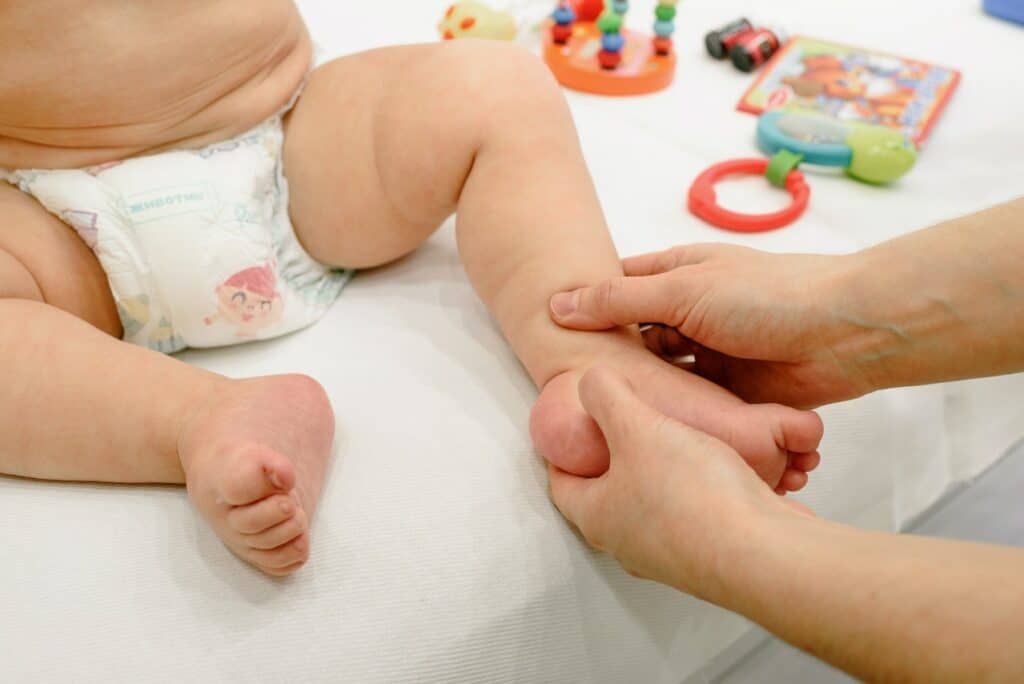Red blotches on a baby’s face when breastfeeding can be a cause for concern for new mothers. While some redness is normal during feeding, persistent or widespread blotches may indicate an underlying issue. Understanding the causes of red blotches and how to identify different types of baby rashes can help parents determine when to seek medical attention and how to prevent future occurrences.
Common causes of red blotches on a baby’s face during breastfeeding include an allergic reaction to food in the mother’s diet, a reaction to soap or detergent, or a fungal infection. It is important to identify the cause of the rash in order to determine the appropriate treatment. In some cases, medical attention may be necessary to prevent complications or further spread of the rash.
Key Takeaways
- Red blotches on a baby’s face during breastfeeding can be a cause for concern and may indicate an underlying issue.
- Common causes of red blotches include food allergies, reactions to soap or detergent, and fungal infections.
- Identifying the cause of the rash is important for determining the appropriate treatment and when to seek medical attention.
Understanding Red Blotches on Baby’s Face When Breastfeeding
Red blotches on a baby’s face while breastfeeding are a common occurrence, and they can be caused by a variety of factors. Understanding the causes of these red blotches is essential in determining the best course of action to take.
One of the most common causes of red blotches on a baby’s face while breastfeeding is simply the physical act of feeding. As the baby suckles, blood flow to the face increases, causing redness and blotching. This is a natural response and is not a cause for concern.
Another possible cause of red blotches on a baby’s face while breastfeeding is a reaction to the mother’s milk. Some babies may be sensitive or allergic to certain foods or substances in the mother’s diet, which can cause redness and irritation on the face. In these cases, it is important for the mother to identify the offending substance and remove it from her diet.
In some cases, red blotches on a baby’s face while breastfeeding may be a sign of a more serious condition, such as an infection or illness. If the redness is accompanied by other symptoms, such as fever or difficulty breathing, it is important to seek medical attention immediately.
Overall, red blotches on a baby’s face while breastfeeding are usually a harmless and natural occurrence. However, if the redness is persistent or accompanied by other symptoms, it is important to consult a healthcare professional to ensure the baby’s health and well-being.
Common Causes of Red Blotches
Breastfeeding is a natural process that provides essential nutrients to babies. However, it is common for babies to develop red blotches on their faces during or after breastfeeding. There are several reasons why this may occur, and it is essential to understand the common causes.

Newborn Rash
Newborn rash, also known as neonatal acne or milia, is a common condition that affects many newborns. It appears as small red or white bumps on the face and is caused by blocked pores. The rash usually clears up on its own within a few weeks.
Eczema
Eczema is a chronic skin condition that causes red, itchy, and inflamed skin. It can be triggered by allergens, such as dust mites, pet dander, or certain foods. Eczema can be managed with proper treatment, including topical creams and ointments.
Overheating
Babies can easily become overheated, which can cause red blotches on their faces. This can happen when they are dressed too warmly or when the room temperature is too high. It is essential to keep babies comfortable and monitor their body temperature to prevent overheating.
Formula
Some babies may have an allergic reaction to formula, which can cause red blotches on their faces. It is important to consult with a healthcare provider if a baby shows signs of an allergic reaction, such as hives, difficulty breathing, or vomiting.
Erythema Toxicum
Erythema toxicum is a common rash that affects many newborns. It appears as red blotches with small white or yellow bumps and usually clears up on its own within a few days.
Heat Rash
Heat rash, also known as prickly heat, is a common condition that occurs when sweat ducts become blocked. It appears as small red bumps and can be prevented by keeping babies cool and dry.
Irritants
Irritants, such as soaps, detergents, or lotions, can cause red blotches on a baby’s face. It is important to use gentle, fragrance-free products and avoid exposing babies to harsh chemicals.
Contagious Conditions
Some contagious conditions, such as measles or chickenpox, can cause red blotches on a baby’s face. It is important to seek medical attention if a baby shows signs of a contagious condition.
In summary, red blotches on a baby’s face during or after breastfeeding can be caused by various factors. It is essential to identify the underlying cause and take appropriate measures to manage the condition.
Identifying Different Types of Baby Rashes
Babies can develop rashes on their face for a variety of reasons. Some rashes are harmless and will go away on their own, while others require medical attention. It is important for parents to be able to identify different types of rashes so they can provide appropriate care for their baby.

Acne
Acne is a common rash that can appear on a baby’s face. It is caused by hormonal changes in the body and is not usually a cause for concern. Baby acne looks like small red or white bumps on the face and can appear anywhere from a few days to a few weeks after birth. It usually goes away on its own within a few months.
Milia
Milia are small, white bumps that can appear on a baby’s face. They are caused by blocked pores and are not harmful. Milia usually go away on their own within a few weeks.
Sweat and Drooling
Babies can develop rashes from sweat and drooling. These rashes usually appear as small red bumps on the face and neck. To prevent these rashes, parents should keep their baby cool and dry and wipe their face often.
Blisters
Blisters on a baby’s face can be caused by a number of things, including infections and allergies. If a baby has blisters on their face, it is important to seek medical attention.
Infections
Infections can cause rashes on a baby’s face. These rashes may be accompanied by other symptoms such as fever and swelling. If a baby has an infection, it is important to seek medical attention.
Sensitive Skin
Some babies have sensitive skin that can become irritated easily. This can cause rashes on the face and other parts of the body. To prevent these rashes, parents should use gentle products on their baby’s skin and avoid harsh chemicals.
Cradle Cap
Cradle cap is a type of rash that appears on a baby’s scalp. It looks like thick, scaly patches of skin and can be accompanied by redness and itching. Cradle cap usually goes away on its own within a few months.
White Bumps
White bumps on a baby’s face can be caused by a number of things, including milia and blocked pores. They are usually harmless and will go away on their own.
Baby Oil
Using baby oil on a baby’s face can sometimes cause a rash. This is because baby oil can clog pores and irritate the skin. To prevent this, parents should use a gentle moisturizer instead of baby oil.
Sores
Sores on a baby’s face can be caused by a number of things, including infections and allergies. If a baby has sores on their face, it is important to seek medical attention.
Newborn Rash
Newborn rash is a common rash that appears on a baby’s face and body. It is usually harmless and will go away on its own within a few weeks.
Creams
Using creams on a baby’s face can sometimes cause a rash. This is because some creams contain harsh chemicals that can irritate the skin. To prevent this, parents should use gentle products on their baby’s skin.
Milk Rash
Milk rash is a type of rash that can appear on a baby’s face. It is caused by an allergic reaction to milk and can be accompanied by other symptoms such as vomiting and diarrhea. If a baby has milk rash, it is important to seek medical attention.
Neonatal Acne
Neonatal acne is a type of acne that appears on a baby’s face. It is caused by hormonal changes in the body and is not usually a cause for concern. Neonatal acne usually goes away on its own within a few months.
Dry Skin
Dry skin can cause rashes on a baby’s face. To prevent this, parents should use a gentle moisturizer on their baby’s skin.
Salmon Patches
Salmon patches are a type of birthmark that can appear on a baby’s face. They are usually harmless and will go away on their own within a few months.
Baby Acne
Baby acne is a common rash that can appear on a baby’s face. It is caused by hormonal changes in the body and is not usually a cause for concern. Baby acne looks like small red or white bumps on the face and can appear anywhere from a few days to a few weeks after birth. It usually goes away on its own within a few months.
When to Seek Medical Attention
If a baby has red blotches on their face when breastfeeding, it’s important to know when to seek medical attention. While most cases are harmless and resolve on their own, there are certain symptoms that may indicate a more serious underlying condition.

If the baby has a fever, cough, or lethargy, it’s important to contact a pediatrician right away. These symptoms may indicate a viral infection or other medical condition that requires prompt treatment.
If the red blotches on the baby’s face are fluid-filled blisters, it may be a sign of herpes or another viral infection. In this case, the baby should be seen by a pediatrician as soon as possible.
Jaundice is another condition that may cause red blotches on a baby’s face. If the baby’s skin and eyes appear yellow, it’s important to contact a pediatrician for evaluation.
Thrush is a common fungal infection that can cause red blotches on a baby’s face. If the baby is having feeding problems or appears to be in pain while breastfeeding, it’s important to contact a pediatrician for evaluation and treatment.
In general, if a baby is experiencing any symptoms that are concerning or unusual, it’s important to seek medical attention. A pediatrician can evaluate the baby and determine if any further treatment or testing is needed.
Treatment and Prevention of Red Blotches
Red blotches on a baby’s face while breastfeeding can be a common occurrence. While it is usually harmless, it can be concerning for new parents. Here are some ways to treat and prevent red blotches on a baby’s face while breastfeeding.

Treatment
If a baby develops red blotches on their face while breastfeeding, the first step is to make sure the baby is comfortable and not in any pain. If the baby is uncomfortable, acetaminophen or ibuprofen can be given to help reduce any pain or discomfort.
To treat the red blotches, the following steps can be taken:
- Gently wash the baby’s face with warm water and a mild soap.
- Apply a moisturizer to the baby’s face to help soothe any dryness or irritation.
- Make sure to keep the baby’s hands clean to prevent any further irritation.
- If the baby is spitting up frequently, try burping the baby more often during feedings.
Prevention
Preventing red blotches on a baby’s face while breastfeeding can be done by taking the following steps:
- Make sure the baby is latching on correctly to prevent any irritation to the skin on the breasts.
- Keep the baby’s face clean and dry.
- Avoid using any harsh soaps or lotions on the baby’s face.
- If the baby has any mongolian spots or stork bites, be gentle when washing their face to avoid irritating the spots.
- If the baby has a yellow color to their skin, it may be due to an excess of red blood cells or bilirubin. In this case, phototherapy may be necessary to treat the condition.
By taking these steps, parents can help prevent and treat red blotches on a baby’s face while breastfeeding. If the redness persists or is accompanied by other symptoms, it is important to consult a healthcare provider.
Related Post: White Lips after Breastfeeding
Frequently Asked Questions
What are the signs of allergy in breastfed babies?
Some signs of allergy in breastfed babies include hives, redness, swelling, and itching on the face, mouth, and body. Additionally, they may experience diarrhea, vomiting, and difficulty breathing.
How can I tell if my baby has a soy allergy while breastfeeding?
If your baby has a soy allergy, they may experience symptoms such as fussiness, colic, diarrhea, vomiting, and rash. If you suspect your baby has a soy allergy, it is best to consult with a pediatrician.
What does a breast milk rash look like on babies?
A breast milk rash, also known as milk rash or newborn rash, appears as small pink or red bumps on a baby’s face. It may also spread to other parts of the body, such as the neck, chest, and back.
Can breast milk cause a rash on a baby’s face?
Yes, breast milk can cause a rash on a baby’s face. Some babies may be sensitive to certain proteins in breast milk, which can cause an allergic reaction and result in red blotches on the face.
What does an allergic reaction look like on a breastfed baby?
An allergic reaction on a breastfed baby may appear as hives, swelling, redness, itching, and difficulty breathing. In severe cases, it may lead to anaphylaxis, which is a life-threatening allergic reaction.
Could my breast milk be causing red blotches on my baby’s face while breastfeeding?
Yes, it is possible that your breast milk could be causing red blotches on your baby’s face while breastfeeding. If you suspect that your breast milk is the cause, try eliminating certain foods from your diet and consult with a pediatrician.

Iesha is a loving mother of 2 beautiful children. She’s an active parent who enjoys indoor and outdoor adventures with her family. Her mission is to share practical and realistic parenting advice to help the parenting community becoming stronger.
